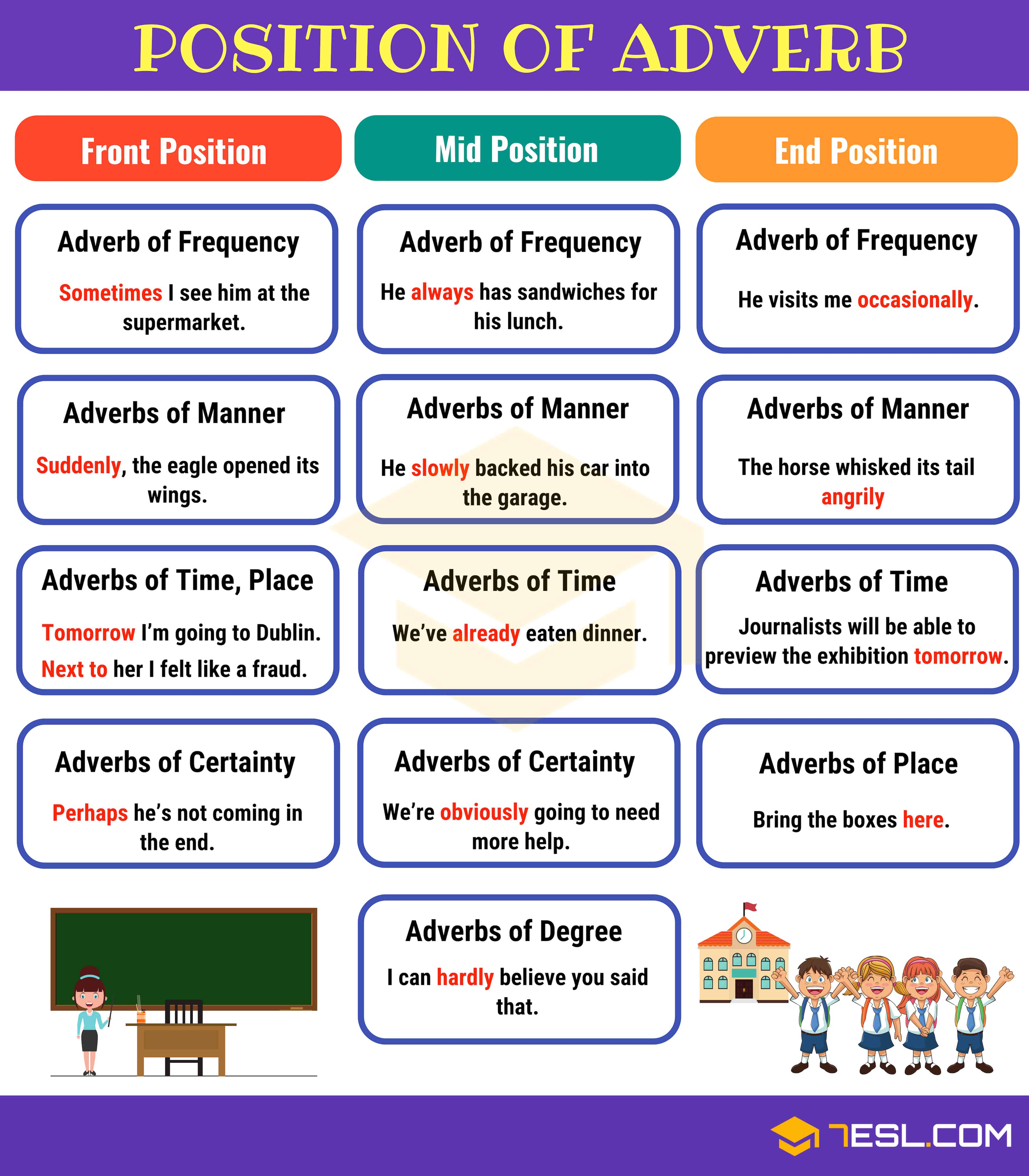Placing adverb before or after verb??? Different types of adverbs go in different positions in the clause. In this lesson, you will learn these position of adverbs in a sentence, also called adverb placement with example sentences.
Position of Adverbs: Place Adverb Before or After Verb?
Where Do You Place Adverbs in a Sentence? Placing adverb before or after verb? Placing adverb in front, mid or end position?
There are three basic positions to place adverb in a sentence as follows.
The front position: before the subject of the sentence. It gives information in advance, to set the scene for the action that follows.
The mid position: the adverb in this position is intimately connected with the verb, generally placed immediately before it. If there is an auxiliary verb, the adverb is placed between the auxiliary and main verb (She resolved she would never see him again.); In case there are two, it is placed between them (This operation has never been performed in this country.). If there is a negative auxiliary, the adverb normally goes after the negative element (We don’t usually go to restaurant on Sundays.), but we can emphasize negation by placing the adverb just before it (She probably won’t meet him.).
The end position: at the end of the sentence.
The most common types of adverb and their position in clause:
- Adverb of frequency – Middle position
- Adverb of time – End position, following adverbs of manner and location
- Adverb of manner – End position, preceding other adverbs
- Conjunctive adverb – Beginning position
- Adverb of Degree – Before the words they describe or emphasize
The following is a detailed list of possibilities. Observe that position may depend on the meaning of the adverb.
Adverb Placement: The Front Position
Conjunctive Adverbs
(Linking adverbs)
Linking adverbs (such as however, then, next, besides, as a result, etc.) are adverbs that are used to link ideas or clauses in spoken discourse or written text. They could also be called conjunctive adverbs in so far as they perform the same sort of function as conjunctions.
Some of them may also be found in the mid position.
However may occupy any of the three positions.
Everyone played well. However, we still lost the game.
Everyone played well; however, we still lost the game.
Everyone played well. We still lost the game, however.
Adverbs of Frequency
Usually, normally, often, frequently, occasionally, sometimes, regularly, always, …
Never, rarely, seldom, … require subject-verb inversion.
This type of adverb can be placed at any to the three positions; the front and end positions are emphatic. The mid position is the most frequent and neutral.
Examples:
Sometimes I see him at the supermarket.
I see him at the supermarket sometimes.
I sometimes see him at the supermarket.
Adverbs of Certainty
perhaps, maybe.
Example:
Perhaps he’s not coming in the end.
Other adverbs of certainty go in the mid-position: definitely, probably, certainly.
They are often found as short answers in discourse.
Adverbs of Time
The front position is possible if the adverb is not the main point of the sentence.
Example:
Tomorrow I’m going to Dublin.
Adverbs of Place
Most often go in the end-position but can also be positioned at the beginning of the sentence, specially in literary writing.
Example:
Next to the bookshelf was a fireplace.
Adverbs of Manner
Slowly, suddenly, badly, quietly…
Examples:
Unfortunately, I’ve got to work on Christmas Eve.
Suddenly, the eagle opened its wings.
Position of Adverbs: Adverb Placement in Sentences – Front Position Image
Adverb Placement: The Mid Position
Adverbs of Manner
Adverbs of manner can be placed in the mid-position when they’re not the focus of the message.
Examples:
He slowly backed his car into the garage.
Menlo angrily replied to a query from a reporter.
Adverbs of Frequency
Never, rarely, sometimes, often, usually, always, ever, etc.
Examples:
He always has sandwiches for his lunch.
I sometimes have to work late.
Adverbs of Time
Already, still, yet, finally, eventually, soon, last, just, etc.
Examples:
We’ve already eaten dinner.
It’s just a cat.
Adverbs of Degree
Some adverbs of degree such as completely, almost, hardly, quite, just…
Example:
I can hardly believe you said that.
Adverbs of Certainty
Definitely, probably, obviously, certainly…
Example:
We’re obviously going to need more help.
Adverbs of Place and Time
Examples:
I now see I was wrong; I will here remark that our products are the best in the market.
Position of Adverbs: Adverb Placement in Sentences – Mid Position Image
Adverb Placement: The End Position
Position of Adverbs: Adverb Placement in Sentences – End Position Image
Adverbs of Manner, Place and Time
Adverbs of manner, place and time most often go in this position but we can put them in front position as in literary or descriptive use.
For example:
The horse whisked its tail angrily.
Journalists will be able to preview the exhibition tomorrow.
The truck picked up speed slowly.
Adverbs of Frequency
Indefinite frequency adverbs are commonly found in the mid-position, only if they are the main focus of attention in the sentence can we place them at the end of the sentence.
For example:
She can be very hurtful sometimes.
He visits me occasionally.
Note:
- When there is more than one adverb in end position, the usual order in written English is adverb of manner + place + time.
For example:
In the accident she was thrown violently against the door. (= manner + place)
- If there are 2 adverbs of time, the first one is the most detailed one.
For example:
The conference will be held on Monday, July 14th 2019.
Adverb Placement Image
Place adverb before or after verb?












0 Comments